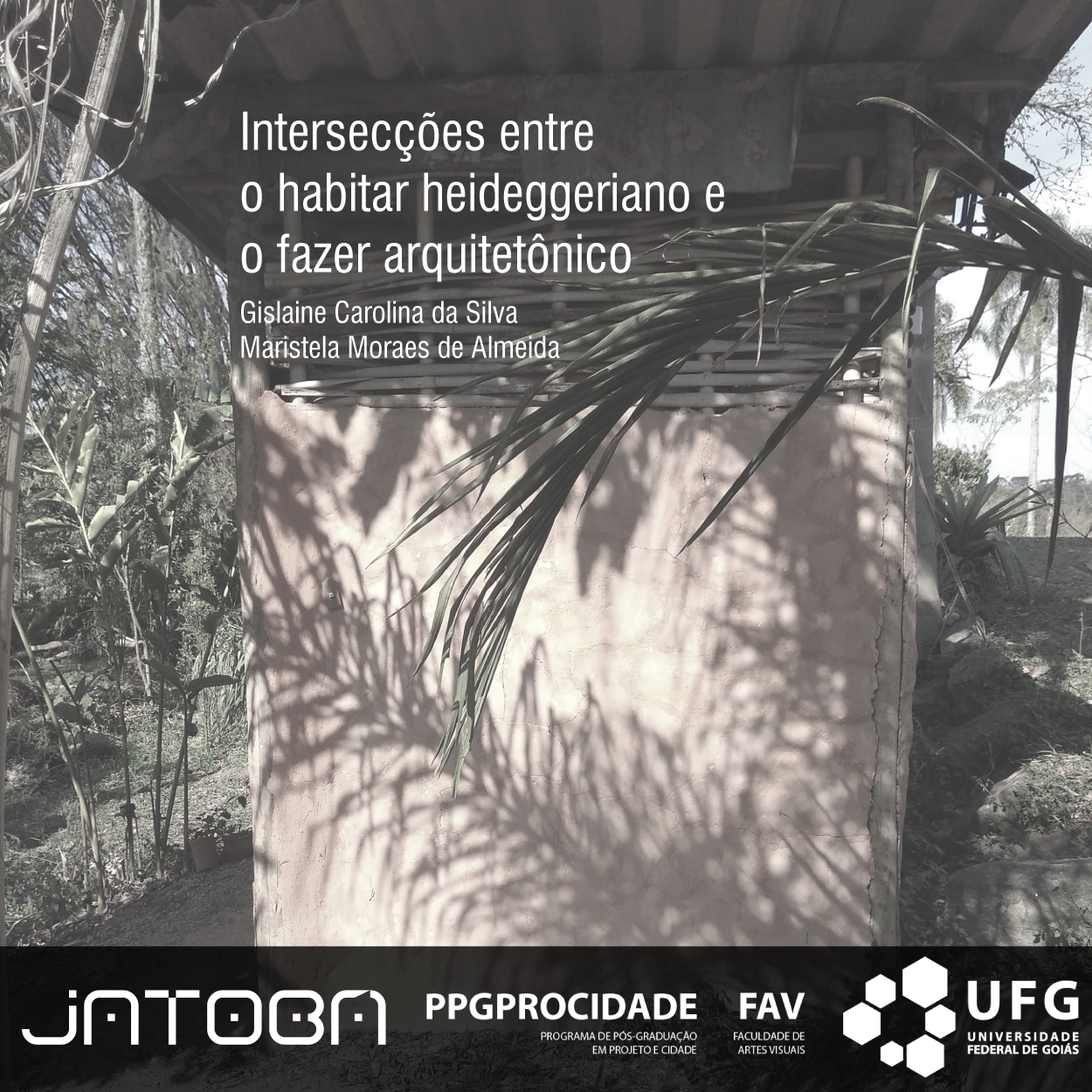Intersections between Heidegger's dwelling and architectural work
DOI:
https://doi.org/10.5216/revjat.v5.76939Keywords:
Architecture, Dwell, SustainabilityAbstract
This article brings a look at the concept of dwelling proposed by the philosopher Martin Heidegger exposed in the essay 'Building Dwelling Thinking' and the intersections of this concept and the projected doing. The study takes the form of intellectual interest, as it aims to deepen the understanding of the concept of dwelling and its relationship with architecture. Architecture dialogues with the concept of dwelling at different times, whether in the relationship it establishes with the place and the elements of the site, or in design decisions and intentions, such aspects range from architectural creation to the final conformation and use of architecture. The concept of dwelling proposed by the philosopher shows that architecture materializes itself as dwelling itself since it results from a set of intentional choices and configures a way of being in the world. It is hoped that the questions presented here will be an invitation to rethink the way we inhabit the world both as people and as professional architects.
Downloads
References
ANDO, Tadao. Por novos horizontes na arquitetura. In: NESBIT, K. (org.). Uma nova agenda para a arquitetura: antologia teórica 1965-1995. Tradução Vera Pereira. São Paulo: Cosac Naify, 2013. Cap. 10, p. 493-498.
CRUTZEN, Paul J.; STOERMER, Eugene F. The "Anthropocene". Global Change Newsletter, [s. l], n. 41, p. 17-18, maio 2000. Disponível em: http://www.igbp.net/download/18.316f18321323470177580001401/1376383088452/NL41.pdf. Acesso em: 16 jan. 2021.
FRAMPTON, Kenneth. Uma leitura de Heidegger. In: NESBIT, K. (org.). Uma nova agenda para a arquitetura: antologia teórica 1965-1995. Tradução Vera Pereira. São Paulo: Cosac Naify, 2013. Cap. 9, p. 474-481.
GLOBAL FOOTPRINT NETWORK (org.). Nosso Passado e Nosso Futuro. Disponível em: https://www.footprintnetwork.org/about-us/our-history/. Acesso em: 18 jan. 2022.
HEIDEGGER, Martin. Construir, habitar, pensar. In: HEIDEGGER, Martin. Ensaios e conferências. 8. ed. Petrópolis: Vozes; Bragança Paulista: Editora Universitária São Francisco, 2012. (Coleção Pensamento humano). p. 125-141. Tradução de Marcia Sá Cavalcante Schuback. Título original: Bauen Wohnen Denken (1951).
LOPARIC, Zeljko. Heidegger. Rio de Janeiro: Jorge Zahar Editor, 2004.
NORBERG-SCHULZ, Christian. O fenômeno do lugar. In: NESBITT, K. (org.). Uma nova agenda para a arquitetura: antologia teórica 1965-1995. Tradução Vera Pereira. São Paulo: Cosac Naify, 2013. Cap. 9, p. 443-461.
PALLASMAA, Juhani. A geometria do sentimento: um olhar sobre a fenomenologia da arquitetura. In: NESBIT, K. (org.). Uma nova agenda para a arquitetura: antologia teórica 1965-1995. Tradução Vera Pereira. São Paulo: Cosac Naify, 2013. Cap. 9, p. 481-489.
PALLASMAA, Juhani. Identidade, intimidade e domicílio: observações sobre a fenomenologia do lar. In: PALLASMAA, Juhani. Habitar. São Paulo: Gustavo Gili, 2017. p. 11-43.
PALLASMAA, Juhani. O espaço habitado: a experiência incorporada e o pensamento sensorial. In: PALLASMAA, Juhani. Habitar. São Paulo: Gustavo Gili, 2017. p. 57-86.
PALLASMAA, Juhani. O senso de cidade: a cidade percebida, recordada e imaginada. In: PALLASMAA, Juhani. Habitar. São Paulo: Gustavo Gili, 2017. p. 45-56.
PAPANEK, Victor. Sentir a habitação. In: PAPANEK, Victor. Arquitetura e Design: ecologia e ética. São Paulo: Edições 70, 1995. Cap. 4, p. 83-115.
SENNETT, Richard. Construir e habitar: ética para uma cidade aberta. Rio de Janeiro: Record, 2018. Tradução de: Clóvis Marques.
SHARR, Adam. Heidegger for Architects. New York: Routledge, 2007. (Thinkers for architects series).
TUAN, Yi-Fu. Espaço e lugar: a perspectiva da experiência. São Paulo: DIFEL, 1983. Tradução de Lívia de Oliveira.

Downloads
Published
How to Cite
Issue
Section
License
Copyright (c) 2023 Jatobá Journal

This work is licensed under a Creative Commons Attribution 4.0 International License.
- Autores mantém os direitos autorais e concedem à revista o direito de primeira publicação, com o trabalho simultaneamente licenciado sob a Licença Creative Commons Attribution 4.0 que permite o compartilhamento do trabalho com reconhecimento da autoria e publicação inicial nesta revista.
- Autores têm autorização para assumir contratos adicionais separadamente, para distribuição não-exclusiva da versão do trabalho publicada nesta revista (ex.: publicar em repositório institucional ou como capítulo de livro), com reconhecimento de autoria e publicação inicial nesta revista.
- Autores têm permissão para publicar e distribuir seu trabalho online (ex.: em repositórios institucionais ou na sua página pessoal) após a publicação inicial nesta revista, já que isso pode gerar alterações produtivas, bem como aumentar o impacto e a citação do trabalho publicado (Veja O Efeito do Acesso Livre).
- Foram feitos todos os esforços para identificar e creditar os detentores de direitos sobre as imagens publicadas. Se tem direitos sobre alguma destas imagens e não foi corretamente identificado, por favor, entre em contato com a revista Jatobá e publicaremos a correção num dos próximos números.














